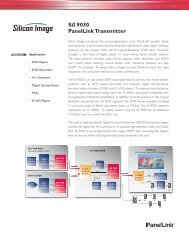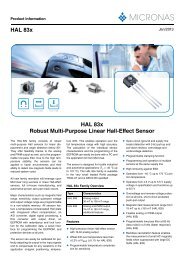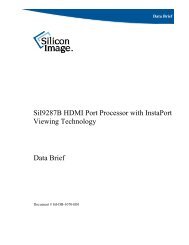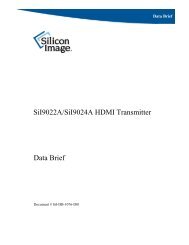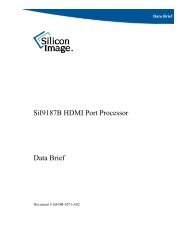You also want an ePaper? Increase the reach of your titles
YUMPU automatically turns print PDFs into web optimized ePapers that Google loves.
ADVANCE INFORMATION<br />
<strong>UAC</strong> <strong>357xB</strong><br />
The audio processing is realized by APU firmware.<br />
The audio building blocks can be split into USB-independent<br />
features such as parametric equalizer, I 2 S<br />
I/O, and blocks which belong to USB feature units,<br />
mixer units, and selection units defined in the USB<br />
Device Class Definition for Audio Devices.<br />
Output Level<br />
dBr<br />
−9<br />
AGC off<br />
AGC on<br />
The USB feature unit provides basic manipulation of<br />
the in<strong>com</strong>ing logical channels and can be controlled by<br />
the standard windows mixer tool. The parameters for<br />
the USB-independent features are predefined in the<br />
internal ROM, in an external EEPROM or a special<br />
host application which drives the IC.<br />
The <strong>UAC</strong> <strong>357xB</strong> supports two logical channels (i.e. left<br />
and right). Multichannel or surround systems, however,<br />
can also be realized using more than one<br />
<strong>UAC</strong> <strong>357xB</strong>, because phase or delay distortion is eliminated<br />
in the device by locking the audio processing to<br />
the USB frame rate. An overview of the architecture is<br />
given in Fig. 3–1 on page 18.<br />
−15<br />
−21<br />
−30 −24 −18 −12 −6 0 +6<br />
dBr<br />
Input Level<br />
Fig. 3–2: Simplified AGC characteristics<br />
Table 3–1: AGC parameters<br />
Parameter Settings Default<br />
If the APU works with a 48 MHz clock it is necessary to<br />
select the reduced feature mode. The blocks, which<br />
are not available in reduced feature mode are shown<br />
with dashed lines in Fig. 3–1 on page 18.<br />
Decay time<br />
8 seconds<br />
4 seconds<br />
2 seconds<br />
20 ms<br />
4 seconds<br />
3.1. DSP Loop<br />
The DSP-Loop block symbolizes the option to route<br />
the audio signal to an external DSP and back into the<br />
<strong>UAC</strong> <strong>357xB</strong> via I²S I/O. This allows to add more audio<br />
processing algorithms.<br />
3.2. Automatic Gain Control<br />
The Automatic Gain Control (AGC) is one of the building<br />
blocks of the feature unit (USB Device Class Definition<br />
for Audio Devices 1.0, page 39).<br />
Different sound sources fairly often do not have the<br />
same volume level. The Automatic Gain Control solves<br />
this problem by equalizing the volume levels within a<br />
defined range. Below a threshold level the signals are<br />
not affected. The level-adjustment is performed with<br />
time constants in order to avoid short-time adjustments<br />
due to signal peaks.<br />
3.3. Quasi-Peak<br />
Two quasi-peak detectors are provided:<br />
1. after the ADCs. This allows the programming of an<br />
AGC in the microcontroller 1) or a VU-meter on the<br />
host side.<br />
2. in the DAC channel. This can be used, e.g., for a<br />
VU-meter on the host side.<br />
The feature is based on using fast attack and slow<br />
decay time constants.<br />
3.4. Bass Control<br />
The bass control provides gain or attenuation to frequency<br />
<strong>com</strong>ponents below a corner frequency of<br />
120 Hz. The bass control works identically on both<br />
channels in a range of −12 dB to +12 dB.<br />
3.5. Treble Control<br />
The treble control provides gain or attenuation to frequency<br />
<strong>com</strong>ponents above a corner frequency of<br />
6 kHz. The treble control works identically on both<br />
channels in a range of −12 dB to +12 dB.<br />
1) not supported by standard microcontroller firmware<br />
Micronas Aug. 20, 2004; 6251-650-1AI 19


